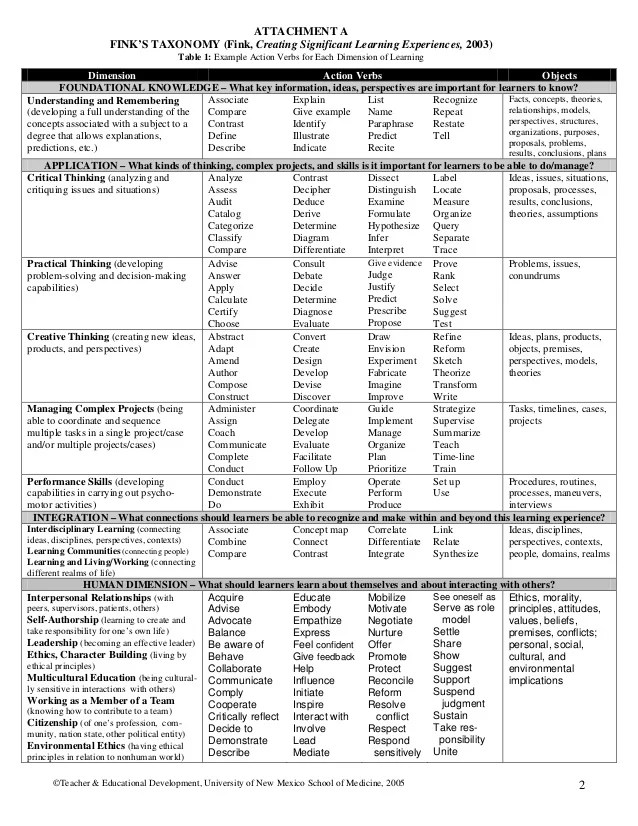Effective Use of Learning Objectives-Fink & Bloom . How do I create a useful learning objective? To create specific, measurable/observable, and results-oriented objectives: It’s helpful to finish the sentence, “After this unit/week/individual session, you should be able to…” Start with an observable action word that captures what the.
Effective Use of Learning Objectives-Fink & Bloom from image.slidesharecdn.com
Objectives Learning EFFECTIVE USE OF PERFORMANCE OBJECTIVES FOR LEARNING AND ASSESSMENT (For Use With Fink’s and Bloom’s Taxonomies) What is a learning.
Source: image1.slideserve.com
Learning objectives. are clear, concise statements that define the expected goal of a curriculum, course, lesson or activity, and describe observable skills or knowledge that will be acquired by.
Source: i.pinimg.com
Three widely-used frameworks for learning goals include Bloom's Taxonomy, Fink's Taxonomy of Learning Experiences, and the Lumina Foundation's Degree Qualifications Profile. Bloom's.
Source: uwm.edu
When students engage in the learning they can use the objective statements to guide their learning, practicing and testing themselves against the objectives. We provide definitions of.
Source: 1.bp.blogspot.com
The Universal Design for Learning framework, which grew out of the larger universal design movement, has been shown to be an effective approach to designing learning experiences that are accessible to.
Source: i.pinimg.com
Taxonomy of Significant Learning (Fink) The SOLO Taxonomy (Biggs & Collis) Bloom’s Taxonomy of Educational Objectives. Bloom’s Taxonomy of Educational Objectives is the.
Source: i.pinimg.com
Strong learning objectives use action words, and many instructors find Bloom’s taxonomy helpful in creating learning objectives and assessment measures. Example Course Blueprint.
Source: i.pinimg.com
Bloom states that learning occurs in three different learning domains: Cognitive, Affective, and Psychomotor. Cognitive domain learning refers to the student’s ability to think and use their.
Source: i.pinimg.com
Bloom’s Taxonomy is a classification of the different outcomes and skills that educators set for their students (learning outcomes). The taxonomy was proposed in 1956 by Benjamin.
Source: s-media-cache-ak0.pinimg.com
Using Bloom’s Taxonomy to Write Learning Objectives April 17th, 2019 Let’s review the effective use of the three taxonomies by applying them to a possible set of learning.
Source: www.eight-interactive.com
Effective Use Of Learning Objectives Fink Bloom writing effective learning outcomes and objectives full presentation, learning objectives quick guide ctle vcu edu, theory bloom s.
Source: i.pinimg.com
By creating learning outcomes using these verbs, you indicate explicitly what the learner must do in order to demonstrate learning at that level. Fink’s Taxonomy Verbs for Learning.
Source: www.researchgate.net
Bloom’s Taxonomy is a hierarchical model that categorizes learning objectives into varying levels of complexity, from basic knowledge and comprehension to advanced.
Source: cdn.slidesharecdn.com
Bloom’s Taxonomy is a powerful tool to help develop learning objectives. It is used by educators, trainers and facilitators to encourage higher-order thinking in their participants by.
Source: i.pinimg.com
EFFECTIVE USE OF PERFORMANCE OBJECTIVES FOR LEARNING AND ASSESSMENT (For Use With Finks and Blooms Taxonomies) What is a learning objective? A learning objective is.
Source: i.pinimg.com
effective use of learning objectives fink bloom below. Effective Social Learning Nathan Loewen 2015-01-15 Shows how professors have an indisputable.
Source: i.pinimg.com
Fink’s Taxonomy of Significant Learning contains six aspects of learning: Foundational Knowledge – Understanding and remembering information and ideas. Application – Developing critical, creative, or.

0 komentar